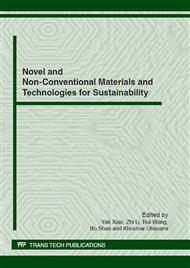[1]
J. Bronius, M. Gediminas, V. Juozas, Analysis of the shear and flexural behavior of masonry with hollow calcium silicate silicate blocks, Engineering Structures. 31 (2009) 827-833.
DOI: 10.1016/j.engstruct.2009.01.001
Google Scholar
[2]
Z. Ximei, G.S. Mark, Structural reliability analysis of reinforced grouted concrete block masonry walls in compression, Engineering Structures. 32 (2010) 106-114.
DOI: 10.1016/j.engstruct.2009.08.020
Google Scholar
[3]
M. Gihad, B.L. Paulo, R.R. Humberto, Mechanics of hollow concrete block masonry prisms under compression: review and prospects, Cement and Concrete Composites. 29 (2007) 181-192.
DOI: 10.1016/j.cemconcomp.2006.11.003
Google Scholar
[4]
J.Z. Xiao, Recycled concrete, Chinese Building Press, Bejing, 2008. (in Chinese).
Google Scholar
[5]
J.Z. Xiao, B. Lei, Carbonation model and structural durability design for recycled concrete, Journal of Architecture and Civil Engineering. 25 (2008) 66-72. (in Chinese).
Google Scholar
[6]
J.Z. Xiao, H. Li, M. Qi, The fatigue strength prediction according to the static strength distribution of recycled aggregate concrete, Journal of Architecture and Civil Engineering. 27 (2010), in press. (in Chinese).
Google Scholar
[7]
J.Z. Xiao, X. Wang, J. Huang, Y.Z. Hu, Analysis of the pressure-receiving performance of regeneration concrete hollow brick. Housing Science. 12 (2005) 32-35. (in Chinese).
Google Scholar
[8]
J.Z. Xiao, X. Wang, Y.Z. Hu, J. Huang, Compressive performance of concrete hollow block masonry with recycled aggregates, Structural Engineers. 22 (2006) 68-71. (in Chinese).
Google Scholar
[9]
J.Z. Xiao, J.D. Huang, H. Li, Z.Y. Xu, Structural performance and design investigation on recycled concrete block masonry during post-earthquake reconstruction. Journal of Sichuan University (Engineering Science Edition). 41 (2009).
Google Scholar
[10]
Chinese Standard GB 50010-2010, Code for Design of Concrete Structures, Chinese Building Press, Beijing, China, 2002. (in Chinese).
Google Scholar
[11]
J.Z. Xiao, J.B. Li, C. Zhang, Mechanical properties of recycled aggregate concrete under uniaxial loading, Cement and Concrete Research. 35 (2005) 87-94.
DOI: 10.1016/j.cemconres.2004.09.020
Google Scholar
[12]
Chinese Standard GB 50011-2008, Code for Seismic Design of Buildings, Chinese Building Press, Beijing, China, 2008. (in Chinese).
Google Scholar


